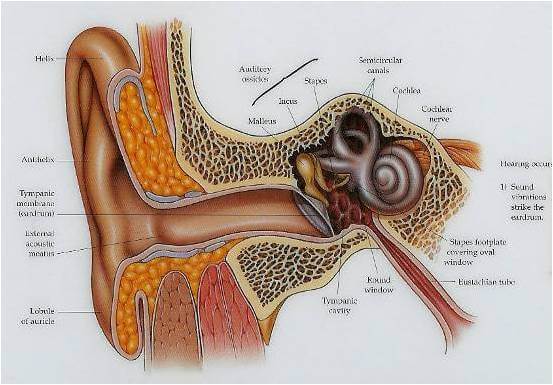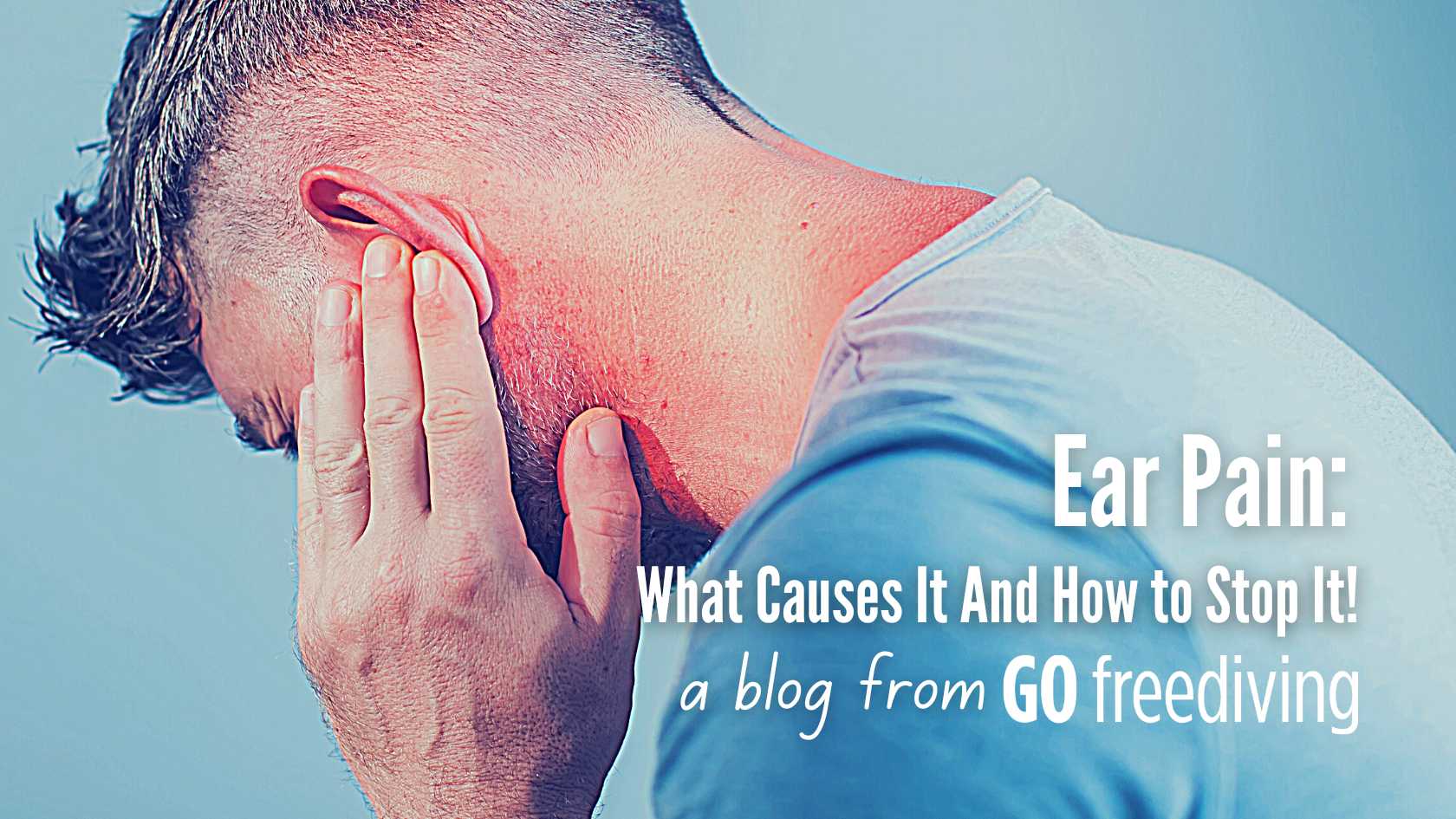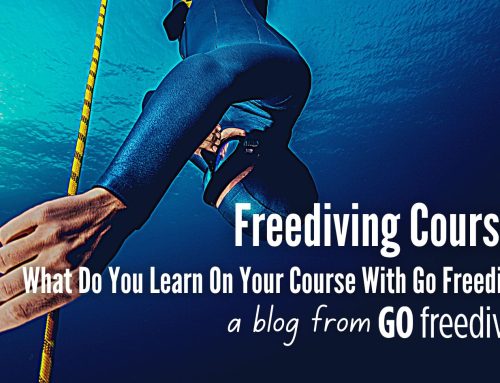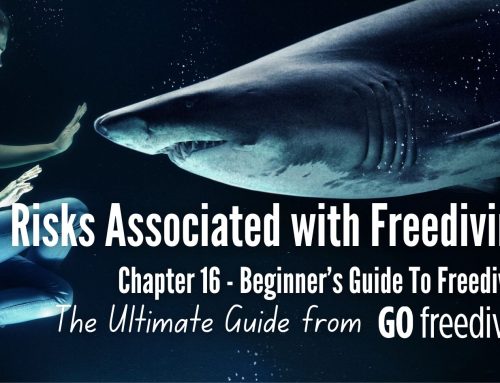Do you experience ear pain when diving? If so, congratulations – you have one of the most commonly reported (and most unwelcome) side effects of diving incorrectly. However, did you know that you should not experience ANY ear pain when diving?
Find out why people experience ear pain when diving, and what steps they need to take to be able to dive pain free.
What Are the Causes of Ear Pain When Diving?

There is no single cause for ear pain when diving, but a checklist of possible causes is always worth working through so that you can get to the root cause. The most common causes of ear pain when diving are:
- Infection
- Foreign object
- Existing Injury
- Pre-existing ear condition
- Some medications
- New injury causing the resulting pain
- Illness such as a cold, sore throat
- Diving soon after flying
- Lifestyle factors such as diet, smoking, allergies etc
- Inadequate equalisation or ‘ear squeeze’
This list is not exhaustive. However, if you have been able to rule out most of these possible causes, what you are most likely left with is diet and equalisation.
Ear Pain When Diving can come in many different forms and present a number of different associated symptoms:
- Centralised ear pain
- Discharge from facial orifices
- Fullness in the ear
- Temporary or permanent hearing loss
- Tinnitus
- Nausea
- Vomiting
- Vertigo
What Should You Do If You Experience Ear Pain When Diving?
Pushing through the pain should not be an option you even consider. The pain is there for a reason indicating something is not right. Continuing to dive or descend will at the very least become increasingly difficult – and painful, but you significantly increase the chances of causing temporary or permanent ear damage. For some, this could even signal the end of diving, full stop.
What Injuries May Occur As A Result Of Ear Pain When Diving?
If you are unlucky enough to suffer an injury to your ear when diving, the most likely injury is a perforated ear drum. This most often occurs during descent, but can also occur during ascent and is caused by ineffective equalisation causing an increased pressure to perforate the eardrum. If it happens on the way up it is due to reverse block with the eardrum perforating or rupturing outwards. More on reverse block below!
If a perforated (or ruptured) eardrum is not the cause, another possibility is severe middle ear barotrauma, which can be equally painful.
What Can You Do To Reduce The Chances Of Ear Pain When Diving?
To reduce the chances of ear pain, you first have to understand where the cause of the pain originates as these are two completely different things. Ear pain when diving most often occurs as a result of the health and condition of the Eustachian tube in our ears
How Do I Equalise My Ears?
When we talk about equalizing the ears, we mean equalizing the middle ear. This is the area behind the eardrum that leads, via the Eustachian tubes, to the back of the throat.
Most people experience the need to equalize this air space when they are on a plane that is taking off or landing, or in a car going down a steep hill. You get a feeling of pressure in your ears, which can be relieved by chewing, swallowing, yawning or moving your jaw. These pressure changes are slow compared to the ones experienced during a freedive, particularly in the first ten meters, and so most people need to use a more powerful equalization technique.
An interesting experiment to see how easily your Eustachian tubes can open is the hum test. You hum and, whilst humming, move your jaw strongly forward. If the hum gets louder inside your head, on the left or right side or both, then you have opened your Eustachian tubes. If this is tricky then you can try pushing the jaw forward and to the left to open up the right side and to the right for the left side. I have always found it difficult to equalize my ears, particularly the right one. When I do the hum test, only occasionally I can open up my left Eustachian tube, but never the right.
The best way to equalise is to master the Frenzel Technique, which uses the back of your tongue to create pressure in the back of your throat, equalizing your ears while keeping your epiglottis shut.
Here is my article and video, which may help explain further:
I Still Can’t Equalise!
There are many issues that people can have with equalization for freediving. Here are some of the most common:
- Failure to equalize frequently enough – In the first 10 meters below the surface, the pressure doubles and you need to frequently equalize.
- Equalizing too late – Preempt every equalization. If you feel strong pressure or pain in your ears then you have left equalizing too late and it may become impossible to equalize.
- Equalizing only one ear – Make sure you have equalized both ears. If you have a ‘good’ ear and a ‘bad’ ear, it sometimes means that you equalize only one but think that you have equalized both.
- Do not strain – Equalize gently but effectively. You do not want to strain when equalizing, as this can over-pressurize your ears (in extreme cases blowing them outwards) and can cause reverse block.
- Unable to equalize – If you cannot equalize, stop and come back to the surface. You want to avoid damaging your ears at all costs.
- Cannot equalize head first – Pulling feet first down the line can be very helpful in learning how to equalize. It is much easier to equalise feet first than head first.
What is the difference between Ear Squeeze and Reverse Block?
Ear squeeze is caused when you descend and is a result of increased pressure on your middle ear causing pain and potential injury. As you descend, the air spaces in our body become smaller and we need to add air into them to return the pressure to normal. As the air space in the middle ear gets smaller, the eardrum is pulled inwards, causing first pressure and then pain. You open up the eustacian tubes so that air can move via the back of your throat into the middle ear, returning the ear drum to its original position.
Reverse block is a serious situation to find yourself in. It means that the tissues have become so congested around your Eustachian tubes that, as you ascend from a dive, they squeeze around the eustachian tube, preventing it from opening. The expanding air inside your middle ear then cannot escape down the back of your throat. As a result, your eardrums bend outwards, and if the pressure is not released then your eardrum will rupture.
If this happens, immediately stop your ascent and hold onto the dive line. Wiggle your jaw and move it forwards as with the hum test above. Do not pinch your nose and try to equalize as this will compound the problem. Ascend as slowly as you can, moving your jaw as you go. If this doesn’t work and you are running out of air, then come straight to the surface, as it is better to have a problem at the surface than at depth.
Ways to Improve Equalization
Here are a number of ways you can help improve your equalisation:
- Stretch the area around your Eustachian tubes
- Use a neti-pot and steam inhalation sessions to cleanse your sinuses.
- When flying, cover your nose and mouth with a layer of fabric or a mask to help you breathe humid and filtered air
- Use Docs Pro plugs.
- Make sure your ears are free of wax.
- Use a silicone barrier in your ears to prevent infection.
- Use an Otovent Dive to help open up the eustachian tubes and practice equalisation.
- Visit a cranial osteopath to see if there is an congestion in the skill that they can relieve.
- Keep hydrated.
- Keep as relaxed as possible when you dive, keep the chin tucked in and preempt every equalisation
What About The Future?
It is true to say that for some, their ability to dive may end as a result of the barotrauma injuries they sustain. However, for most, with practice, a change of diet and a careful reintroduction to diving, a return to diving is usual.
Want to learn about mask squeeze?
Learn to freedive with Go Freediving
Go Freediving is the longest established, most experienced and friendliest freediving course provider in the UK, led by world class freediving instructor trainer Emma Farrell, and her team of personally trained instructors. No other course provider has such a good instructor to student ratio, safety record and personal touch.
Whether you’re freediving in November or any other time of year, a beginner dipping your toes into the world of freediving, a seasoned pro looking to turn professional, or simply a freediver of any level who wants the best freediving holiday in the world, we’re here for you!
Also check out our online guide, The Beginners Guide to Freediving by clicking here!
Keep in touch with everything Freediving
Subscribe to our mailing list for weekly newsletters with exclusive articles, news, films, offers and more!
And check out You Tube!






Leave A Comment